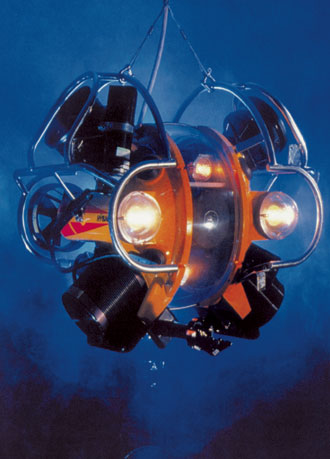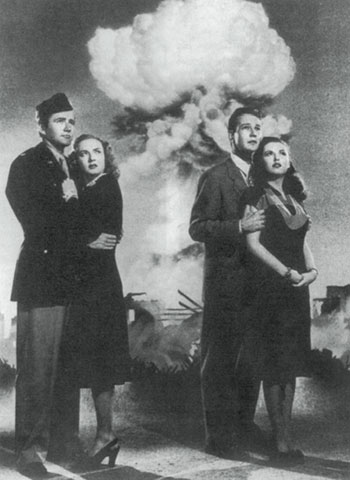Short takes on three books
By Roger Harris, Greg Ross, David Schoonmaker
The Smaller Majority · Oceans: An Illustrated Reference · The Bomb: A Life
The Smaller Majority · Oceans: An Illustrated Reference · The Bomb: A Life

DOI: 10.1511/2006.60.380
THE SMALLER MAJORITY. Piotr Naskrecki. Harvard University Press, $35.
In The Smaller Majority, Piotr Naskrecki, director of the Invertebrate Diversity Initiative at Harvard's Museum of Comparative Zoology, explores a miniature world, transporting the reader through three major biomes—rainforest, savanna and desert—to encounter the microcosms of animals that mostly would "fit inside a matchbox." Naskrecki's photography offers insights into the biology and conservation of these creatures; the sumptuous illustrations that make up the bulk of the book are obviously the work of a fine craftsman.

From The Smaller Majority
The word majority in the book's title refers to the many individuals and species of invertebrates (the main subject of the book), which are much more numerous than the vertebrates (represented here by amphibians and reptiles). The examples Naskrecki uses to demonstrate underlying biology are superb. For example, the photograph at right of an African tree frog (Leptopelis hyloides) shows its enlarged toe pads and grasping fingers (adaptations to an arboreal lifestyle), illustrating evolutionary convergence with superficially similar South American tree frogs.
With spectacular and sometimes bizarre images of beetles, spiders, katydids, land crabs, caterpillars, mantids and the like, Naskrecki drives home his point that tiny creatures display enormous biodiversity. The more we know about these creatures, the more aware we become of what we are losing. Since the early 1990s, biologists have advocated the conservation of biodiversity hotspots to better protect the small and unseen, and Naskrecki's book solidly bolsters the approach. The Smaller Majority will go a long way toward increasing the public's appreciation of, and support for conserving, small animals.—Roger Harris
OCEANS: An Illustrated Reference. Dorrik Stow. University of Chicago Press, $55.
The ocean is a wilderness reaching round the globe," wrote Thoreau, "wilder than a Bengal jungle, and fuller of monsters." He would have been well pleased with Dorrik Stow's colorful, comprehensive book Oceans: An Illustrated Reference.

From Oceans
Stow, an oceanographer at England's Southampton Oceanography Centre, has set himself an enormous undertaking: preparation of a comprehensive portrait of the world's oceans, taking in everything from planetary formation and geology to biology and undersea exploration—like that conducted by the robotic explorer pictured at right.
Accordingly, Stow divides the volume into two parts. The first examines the physical nature of the oceans, including waves, tides, currents and seawater chemistry. The second appreciates the almost inconceivable diversity of marine life, which may include as many as 20 million species, although only a fraction of these have been identified.
Sadly, the story of today's oceans is largely one of human industry and of our queerly ambivalent attitude toward "the blue continent." The sea provides the main source of protein for more than 1 billion people, but we spill an estimated 4 million metric tons of oil into it every year, plus untold effluent and waste, which is why a despairing Jacques Cousteau called the sea "the universal sewer."—Greg Ross
THE BOMB: A Life. Gerard DeGroot. Harvard University Press, $27.95.

From The Bomb
In 1942 Enrico Fermi, Leo Szilard and Eugene Wigner began building the world's first nuclear reactor beneath the grandstands of the University of Chicago's football field. In 1963, I visited that very field with my dad, who told me about the reactor and the bombs to which it led. That same year, the Limited Test Ban Treaty was signed, and the Nuclear Age, in the naive sense, began to wind down. Only much later would I come to understand the relation between those events and certain oddities of growing up in the 1950s: the distinctive yellow and black signs near the doors of sturdy buildings, the drills at school during which we huddled beneath our desks, the underground playrooms in neighbors' backyards.
Gerard DeGroot's The Bomb: A Life is the catalyst that has led me to reflect on these things. DeGroot, who writes with grace and wit, offers an overwhelming array of fascinating yet bizarre facts and anecdotes, and he masterfully reveals the complex interface between physicists and politicians. But more than anything, his book gives form to the central cultural feature of the time: the shadow of the mushroom cloud.
The Bomb chronicles nuclear weapons from their conception in the 1930s through the end of the century, focusing mainly on the decisions made from 1940 to 1962 to develop and use devices of unimaginable destruction and become ironically reliant on them for maintaining peace. Was it the Soviets or the Americans who pushed the crazy escalation in megatons and warheads? The answer isn't so simple as I once thought.
I count this among the best history books I've read. DeGroot's effort clarifies a bewildering and, in retrospect, insane time.—David Schoonmaker
Click "American Scientist" to access home page
American Scientist Comments and Discussion
To discuss our articles or comment on them, please share them and tag American Scientist on social media platforms. Here are links to our profiles on Twitter, Facebook, and LinkedIn.
If we re-share your post, we will moderate comments/discussion following our comments policy.